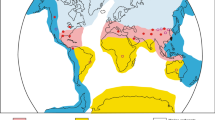Abstract
Organic lipids with different occurrence modes in a sedimentary core in a subtropical freshwater lake, Gucheng Lake, were sequentially extracted, separated and analyzed. The down-core variations of OEP index of alkanes, C18:2/C18:0 ratios of fatty acids, ratios of bound, fatty acids to free fatty acids, thermo-maturity indices of hopanoid hydrocarbons and rerative concentrations of sedimentary minerals revealed an evident increasing in allochthonous input from rock detritus below 12.28 m in the sedimentary profile. The distribution pattern of tightlybound β-hydroxy fatty acids indicated a difference in bacterial communities above and below the boundary, as well as the gammacerane index may assign a significant change in lake water salinity. The evidence, in general, suggested that a significant paleoenvironmental change had taken place in ca. 9.6 kaBP on the regional basis.
Similar content being viewed by others
References
Brassell, S. C., Applications of biomarkers for delineating marine palaeoclimatic flunctuations during the Pleistocene,Organic Geochemistry, New York: Plenum Press, 1993. 699–738.
Jasper, J. P., Hayes, J. M., A carbon-isotopic record of CO2 levels during the Late Quaternary,Nature, 1990, 347: 462.
Wang Sumin, Yang Xiangdong, Ma Ynnet al., Environmental change of Gucheng Lake of Jiangsu in the past 15 ka and its relation to palaeomonsoon,Science in China, Ser. D, 1996, 39(2): 144.
Goossens, H., Rjpstra, W. I. C., Düren, R. R.et al., Lipids and their mode of occurrence in bacteria and sediments-I. A methodological study of the lipid composition of Acinetobacter calcoaceticus LML) 79/41,Org. Geochem., 1989, 14: 15.
Albaiges, J., Extractable and bound neutral lipids in some lacustrine sediments,Adwances in Organic Geochmistry 1983, Oxford: Pergamon, 1984, 223–236.
Zhang Gan, Sheng Guoying, Fu Jiamo, Bound lipids in lacustrine sediments in Gucheng Lake, East China.Chinese Science Bulletin, 1997, 42(21): 1749.
Marr, A. G., Ingraham, J. L., Effect of temperature on the composition of fatty acids inEscherichia coli, J. Bacteriol., 1962, 84: 1260.
Kawamura, K., Ishiwatari, R., Polyunsaturated fatty acies in a lacustrine sediment as a possible indicator of paleoclimate,Geochem. Cosmochim. Acta, 1981, 45: 149.
Zhang Gan, Sheng Guoying, Fu Jiamoet al., Pnleoclimatic significance of unsaturated fatty acids in sediments from the upper 16m of a sedimentary core in Gucheng Lake, Fastern China, inWater-Rock Interaction: Proceedings of the 8th International Symposium on Water-Rock Interaction, Rotterdam: Balkema, 1995, 287–291.
Bray, E. E., Evans, E. D., Distribution of n-paraffins as a clue to the recognition of source beds,Gcochim. Cosmochim. Acta, 1961, 22: 2.
Peters, K. E., Moldowan, J. M.,The Biomarker Guide: Interpreting Molecular Fossils in Petroleum and Ancient Sediments, Prentice Hall Inc., 1993.
Wang Ruiliang, Fu Jiamo, Sheng Guoying, Quantification and distribution of hiomarkers in salt lake sediments,Annual Report of the State Key Laboratory of Organic Geochemistry, GAS (in Chinese), 1987, 109–120.
Fu Jiamo, Sheng Guoying, Peng Pinganet al., Peculialities of salt-lake sediments as potential source rock in China, inAdvances in Organic Geochemistry 1985, Oxford: Pergmon, 1986, 119–126.
Fan Shanfa, Fu Jiamo, Eglinton. G., Biomarkers and methyl benzohopanes in shallow freshwater sediments,Annual Report of the State Key Laboratory of Organic Geochemistry, GAS (in Chinese), 1987, 93–100.
Schenck, P. A., Biomarkers as indicators to sediment environment,Annual Report of the State Key Loboratory of Organic Geochemistry, CAS (in Chinese), 1986, 172–182.
Goossens, H., Rjpstra, W. I. C., Bacterial contribution to sedimentary organic matter; a comparative study of lipid moieties in bacteria and recent sediments, inAdvances in Organic Geochemistry 1985, Oxford: Pergamon, 1986, 683–696.
Barnes, M. A., Barees, W. C., Organic compounds in lake sediments, inLakes-Chemistry, Geology, Physics, New York: Springer, 1978, 127–152.
Sheng Jie, Wang Sumin, Liu Songyuet al., A seawater invasion event in 9.6 kaBP in Gucheng Lake,Chinese Science Bulletin (in Chinese), 1997, 42: 1412.
Author information
Authors and Affiliations
About this article
Cite this article
Zhang, G., Sheng, G., Fu, J. et al. Molecular organic geochemical evidence for paleoenvironmental changes at 11.87–12.28 m in GS-1 sedimentary core, Gucheng Lake, East China. Chin.Sci.Bull. 44, 1407–1411 (1999). https://doi.org/10.1007/BF02885993
Received:
Issue Date:
DOI: https://doi.org/10.1007/BF02885993




